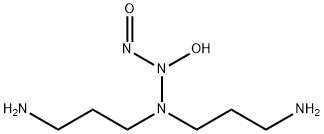DPTA NONOATE

|
- ₹0
- Product name: DPTA NONOATE
- CAS: 146724-95-0
- MF: C6H17N5O2
- MW: 191.23
- EINECS:
- MDL Number:MFCD00797678
- Synonyms:(Z)-1-[N-(3-AMINOPROPYL)-N-(3-AMMONIOPROPYL)AMINO]DIAZEN-1-IUM-1,2-DIOLATE;3,3'-(HYDROXYNITROSOHYDRAZINO)BIS-1-PROPANAMINE;3,3μ-(Hydroxynitrosohydrazino)bis-1-propanamine, DPTA NONOate;DPTA/NONO;DPTA NONOATE;DIPROPYLENETRIAMINE NONOATE;1g, 2 5 500Mg;1-Propanamine, 3,3'-(2-hydroxy-2-nitrosohydrazinylidene)bis-
| Manufacturer | Product number | Product description | Packaging | Price | Updated | Buy |
|---|
Properties
Boiling point :331.9±52.0 °C(Predicted)
Density :1.33±0.1 g/cm3(Predicted)
storage temp. :−70°C
form :White to off-white solid.
pka :5.23±0.69(Predicted)
Water Solubility :Highly soluble in water
Density :1.33±0.1 g/cm3(Predicted)
storage temp. :−70°C
form :White to off-white solid.
pka :5.23±0.69(Predicted)
Water Solubility :Highly soluble in water
Safety Information
| Symbol(GHS): |

|
|||||||||||||||||||||||||||||||||||
|---|---|---|---|---|---|---|---|---|---|---|---|---|---|---|---|---|---|---|---|---|---|---|---|---|---|---|---|---|---|---|---|---|---|---|---|---|
| Signal word: | Warning | |||||||||||||||||||||||||||||||||||
| Hazard statements: |
|
|||||||||||||||||||||||||||||||||||
| Precautionary statements: |
|
Description
DPTA NONOate is a NO donor. It spontaneously dissociates in a pH-dependent, first-order process with a half-life of three hours and five hours at 37°C and 22-25°C, pH 7.4, respectively, to liberate 2 moles of NO per mole of parent compound.More related product prices
NOC-18 SODIUM NITROPRUSSIDE DIHYDRATE NOC-5 S-NITROSOGLUTATHIONE MAHMA NONOATE NOC-7 SPERMINE NONOATE DEA NONOate NOC-12 NOR-3 V-PYRRO/NO DIPROPYLENETRIAMINERelated product price
- SODIUM NITROPRUSSIDE DIHYDRATE
₹873-51380 - S-NITROSOGLUTATHIONE
₹10380-38980.83 - MAHMA NONOATE
₹9785.8






